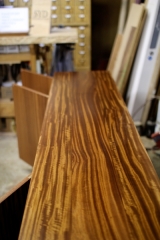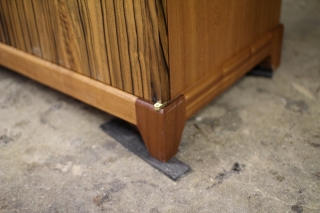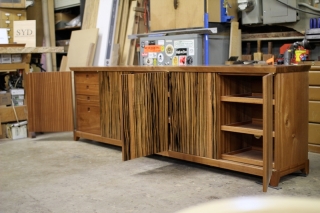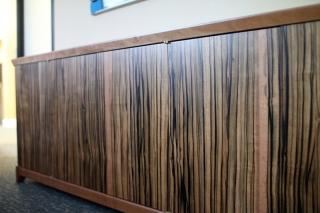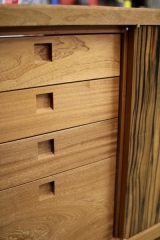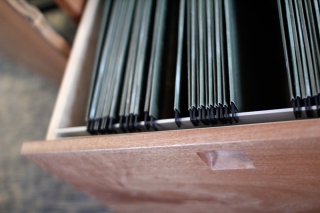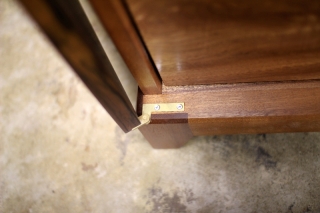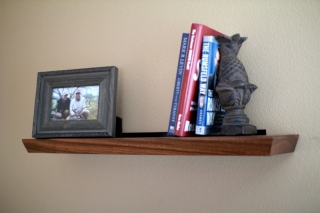
This is the follow up project to the Harmonson Desk. Like I mentioned in the desk post, this client likes to keep his room uncluttered. So for the credenza, he asked me to create a design where everything can be hidden except for a phone which will sit on top of it. All of the office equipment and accessories would need to be stored in there and be able to plug in. He also needed access to a hanging file cabinet, so we incorporated a hanging file drawer into the design.
The credenza is on the bigger side- measuring 8′ long, 16″ deep and 30″ high. Most of the design elements are stripped down to emphasize the Macassar ebony- the star of the show. I focused on subtlety and added small bevels where the ‘feet’ and ‘head’ meet the body. The credenza is divided into five sections, each with a door in front of it. The very left section housed 4 drawers with one of them being a hanging file cabinet drawer. The 2nd to the left and the middle section is one long section with adjustable shelves. The 2nd from the right has small adjustable shelves, and the far right has 3 pull out trays.
To match the desk, we chose mahogany and Macassar ebony. Most of the credenza is made from solid mahogany and the doors are made from Macassar ebony veneered panels. Most commercial plywood has a bookmatch sequence which means they take the veneer slices in the order it was cut and the flip it so it creates a mirror image of the figure. This creates an interesting look, but I find that the repetition becomes all too evident when people use commercial plywood- especially when the veneer slices are narrow in width. The reason solid wood construction is so pleasing to look at is because no two boards are alike. It’s complete randomness- although the boards should be similar in figure and color. To achieve that random look, I ordered Macassar ebony veneer all from different flitches (trees). That way, there’s no chance I will get repetition of any one grain pattern.
The drawers are made with hand cut dovetails and I used side mount drawer guides. The reason for that is in order to maximize the available space for the hanging files, I oriented the drawer to make it into a lateral file system (which means that the hanging files slide side-to-side instead of front-to-back). This orientation meant that the back of the drawer had to be able to pull out past the front of the drawers above it. This called for special guides called overextension guides and they’re only available as side mount drawers. It’s a shame to have to cover up some of the hand cut dovetails with these metal guides, but functionality trumps aesthetics. The drawer fronts have a recessed cut-out for the drawer handles due to the fact that the door needs to be able to close.
For the hinges, I used Brusso offset knife hinges because I wanted the doors to be able to swing 270 deg. for the outside doors (which means it can fold back around the cabinet sides) and 180 deg. for the internal doors (which means that the doors can completely overlap the doors that are next to it.) You don’t see these hinges very often and they are reserved for fine furniture because it’s difficult to install them. First, they have to be morticed into the cabinet and doors, but also there is no adjustability once it’s in, so everything has to be made perfect. Since I wanted the doors to be able to overlap the next door over, it meant that I couldn’t have any handles projecting from the doors. I also didn’t want anything recessed into the doors since that will disrupt the flow of the Macassar ebony, so I ended up using magnetic push latches made from Blum.
I also created a small shelf for him so he can display his photos or some books. It repeats the angle taken from the top of the credenza and has a black steel backsplash detail to anchor the shelf to the wall.
